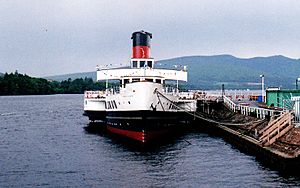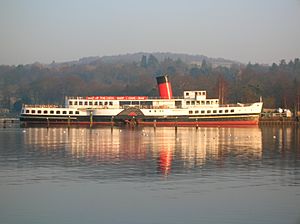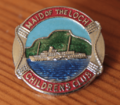PS Maid of the Loch facts for kids

PS Maid of the Loch at the pier at Balloch, Loch Lomond where she is undergoing restoration.
|
|
Quick facts for kids History |
|
|---|---|
| United Kingdom | |
| Name | PS Maid of the Loch |
| Owner | British Transport Commission |
| Operator | Caledonian Steam Packet Company |
| Route | Loch Lomond |
| Builder | A. & J. Inglis of Pointhouse, Glasgow |
| Yard number | 1474P |
| Launched | 5 March 1953 |
| In service | 25 May 1953 |
| Out of service | 31 August 1981 |
| Homeport | Balloch |
| Honours and awards |
Last paddle steamer built in a Clyde shipyard |
| Name | PS Maid of the Loch |
| Owner | Loch Lomond Steamship Company |
| Route | Static |
| Acquired | 1995 |
| Homeport | Balloch, Loch Lomond |
| Identification | IMO number: 5217567 |
| Status |
|
| General characteristics | |
| Class and type | Passenger |
| Type | Paddle steamer |
| Tonnage | 555 grt |
| Length | 208 feet (63 m) |
| Beam | 51 feet (16 m) |
| Draught | 4 ft 6 in (1.37 m) |
| Installed power | 900 ihp (670 kW) |
| Propulsion | Steam, compound diagonal engines by Rankin & Blackmore, Greenock |
| Speed | 13.75 knots (25.5 km/h) |
| Capacity | Passengers: 1000 |
The PS Maid of the Loch is a special paddle steamer that used to sail on Loch Lomond in Scotland. She is famous for being the very last paddle steamer built in Britain.
For 29 years, she carried passengers across the beautiful loch. Today, she is being carefully restored at Balloch pier. You can visit the Maid of the Loch from Easter to October every day. During winter, she is open on weekends. She now has a fresh look with red, white, and black colours. Her funnel is red with a black top.
Contents
Building the Maid of the Loch
The Maid of the Loch is the last of many steamers that sailed on Loch Lomond. These boats started appearing around 1816. This was just four years after Henry Bell began his first passenger steamboat service. That service was on the nearby River Clyde.
In 1950, the British Transport Commission decided to build a new paddle steamer. They wanted it to be the biggest inland waterway vessel in Britain. This new ship would replace two older ones, the Princess May and Prince Edward.
How She Was Built
The Maid of the Loch was built by a company called A. & J. Inglis in Glasgow. She was launched on March 5, 1953. She started carrying passengers later that same year.
She was built in a special way, known as a "knock-down" ship. This means she was put together at the shipyard first. Then, she was taken apart into sections. These sections were sent by train to Balloch at the south end of Loch Lomond. There, her parts were put back together on a special slipway.
The ship is 208 feet (63 metres) long. She weighs 555 grt. Her steam engine is a two-cylinder compound diagonal type. It was perfect for sailing on the loch. When she first sailed, the Maid of the Loch was painted white with a buff (light yellow-brown) funnel. The Caledonian Steam Packet Company operated her.
Sailing on Loch Lomond
The Maid of the Loch started her journeys from Balloch pier. At first, she sailed all the way to Ardlui at the very north end of the loch. Later, her last stop was at Inversnaid, a few miles before Ardlui. She would then cruise to the head of the loch.
Over the years, the ship changed owners. In 1969, she moved to the Scottish Transport Group. Then, in 1973, she became part of Caledonian MacBrayne.
Why She Stopped Sailing
Like many other steamers, the Maid of the Loch faced money problems. She made her last trip on August 31, 1981. One big issue was that some of the piers on the loch were falling apart. Others became too shallow for the large ship to reach. Some piers were not even built for a vessel as big as the Maid of the Loch.
After she stopped sailing, many attempts were made to bring her back. But none of them worked. She slowly started to look sad and worn out at the side of the loch.
Bringing Her Back to Life: Restoration Efforts
In 1992, the Dumbarton District Council bought the Maid of the Loch. They started working to restore her. In 1995, a group of local people who loved the ship formed a charity. This group, the Loch Lomond Steamship Company, took over the ship. They continued the restoration work. By autumn 2000, she was ready to be a static attraction. She had a cafe, a bar, and a place for events.
The Slipway Repair
A very important part of the restoration was fixing the slipway next to the pier in Balloch. Since the ship couldn't go to a dry dock (a place to repair ships out of water) because Loch Lomond isn't connected to the sea, a special slipway was built. This slipway had a steam-powered cradle that could pull the ship out of the water.
This slipway had also fallen apart by the 1990s. Luckily, a grant from the Heritage Lottery Fund helped fix it. Scottish Enterprise Dunbartonshire and West Dunbartonshire Council also helped. This allowed the paddle steamer to be lifted out of the water on June 27, 2006.
Ongoing Restoration
Fundraising for the next steps of the restoration is still happening. Money has come from the Wolfson Foundation and the Paddle Steamer Preservation Society. The Scottish Government also gave £950,000 from its Regeneration Capital Grant Fund.
In January 2019, there was an attempt to pull the Maid of the Loch onto her slipway. But the ship "slipped its ties" and slid back into the loch. An investigation is now underway to find out what happened. They will try to lift her out of the water again later.
Restoration work continues on the ship's inside. The goal is to make it look like it did in the 1950s. They are also adding modern things like a lift between decks. Her engines and paddles will also be able to turn slowly, powered by a boiler on the pier.
In 2019, the project faced a setback when a funding bid was not successful. However, the Scottish Government provided £950,000. This money is meant to help improve Balloch and Haldane. The charity is now working on new plans to get more public funding.
Images for kids



